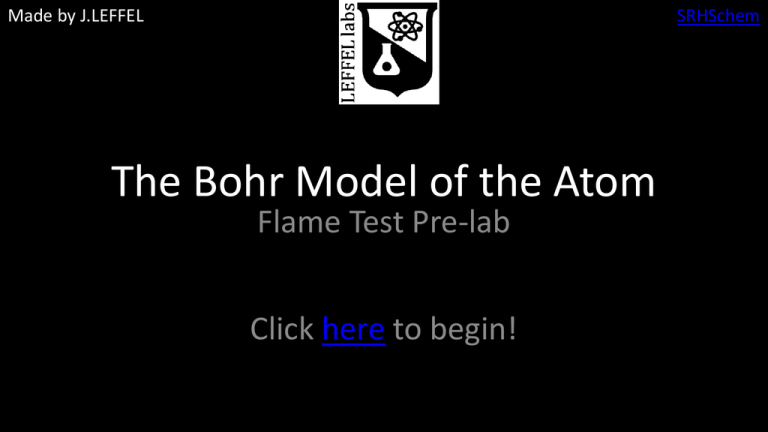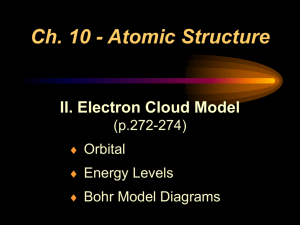1 S Bohr Model of the Atom and Flame Test Prelab
advertisement

Made by J.LEFFEL SRHSchem The Bohr Model of the Atom Flame Test Pre-lab Click here to begin! After discovering the atomic nucleus, Rutherford used existing ideas about the atom to propose an atomic model in which each electron moved around the nucleus in an orbit. Electron Orbit Nucleus - ? Rutherford’s model only explained a few simple properties of atoms. Many observations made by scientists could not be explained by this model… - + ? Rutherford Model How do atoms combine to form molecules? ? ? ? ? ? What about atomic emission spectra? Why do objects change colors if they are heated? Are the electrons all the same distance from the nucleus? Why do metal ions give off characteristic colors when burned in a flame? What keeps the electrons (negative) from “sticking” to the nucleus (positive)? Click to Continue One big problem with Rutherford’s model is that it could not explain the atomic emission spectra of elements. The atomic emission spectrum is the “fingerprint” of light given off by an atom when it absorbs energy. Each element has its own unique atomic emission spectrum. Can you identify the element(s) present in the unknown? Justify your answer and explain how you came to it. Click to Continue In order to explain the atomic emission spectra of different elements, a scientist named Niels Bohr turned his focus onto studying the hydrogen atom. He choose hydrogen because it was the simplest system he could study: an atom with only one proton and one electron. Why did Bohr choose to study hydrogen? Bohr proposed a model for the hydrogen atom that included several energy levels, any of which could be occupied by hydrogen’s one electron. Nucleus + What happens to the distance between energy levels as they increase? Bohr Model Energy Levels Click to Continue The Basics of Bohr 1. The atom has a tiny, dense, and positive nucleus. (Rutherford) 2. Energy levels exist at set distances from the nucleus, each representing a specific amount of energy. These energy levels are numbered. These electrons have the same energy since they are in the same energy level. - 3. An electron’s energy is equal to it’s energy level. 4. The farther away an energy level is from the nucleus, the higher it’s energy. - - + N=1 The N=1 electron has less energy than the N=4 electron. N=2 N=3 N=4 5. An electron cannot exist floating between energy levels. Draw and label the Bohr model of the atom. Summarize the basics. Click to Continue The lowest energy is called the ground state. + - - - - Because it has the least amount of energy, the ground state is the most stable. Click on the electron in the ground state. Wrong! • Remember: the ground state is the least energetic state that the electron can have. Click here to try again. Correct! • The energy levels in an atom are like a set of uneven stairs. • The energy level closest to the nucleus has the lowest energy. • Energy is needed to “pull” the negative electron away from the positive nucleus. • The farther the electron is pulled, the more energy is required, so energy levels farther away have higher energies. Explain how the picture relates to atoms and the Bohr model. Click to Continue When an atom absorbs energy, its electrons will “jump up” in energy level. This is called the excited state. An electron in the ground state, orbiting the nucleus. The electron absorbs energy. - - + And “jumps up” to a higher energy level. Compare the ground state and the excited state. The electron is now in an excited state. Click to Continue The excited state is high energy, making it very unstable. Energy + Allowing it to - “relax” down to a lower energy level. - To regain it’s stability, the electron will reemit the energy it has absorbed, moving to a lower energy level. The electron remits the extra energy it absorbed Explain how electrons move between energy level. Click to Continue How does this explain the atomic emission spectrum? Wasn’t that the big problem with Rutherford’s model? Depending on how many energy levels the electron drops, the electron emits different amounts of energy. These energy changes correspond to the frequencies shown on the atomic emission spectra. Only certain frequencies are visible to the human eye. List all of the visible energy transitions and the colors that correspond. (Ex: Dropping from N=7 down to N=2, violet.) Complete atomic emission spectrum of hydrogen Energy Changes Click to Continue Visible Emission Spectrum of Hydrogen Infrared N=7 N=6 N=5 N=4 The energy given off by each energy change matches exactly to the frequencies found on the emission spectrum for hydrogen. N=3 N=2 N=1 Ultra Violet See how they match? There are other energy changes as well, but they are not visible to the naked eye. These include ultra violet (UV rays) and infrared (heat). Complete the sentence: The energy given off during an infrared transition is too (small/large) to be seen by the human eye, whereas the energy given off during an ultraviolet transition is too (small/large) to be seen by the human eye. Click to Continue What applications does this have? • • • • • Fireworks Composition of the Stars Authenticity of Art Neon Signs Understanding the atom has also lead to countless advances, discoveries, and inventions. Without it your life would be completely different. Click to Continue How will we use this today? We will perform a flame test. A flame test is a procedure that can be used to identify metal ions. The flame supplies energy to the electrons of the metal atoms, causing them to jump up in energy level to an excited state. Each type of metal atom gives off characteristic colors as the electrons relax back down in energy level. First, you will observe the color of the flame for several metal cations. Then, you will be given two unknowns; you must identify them by comparing the color of their flames to the ones your have already observed. What is a flame test? Explain. Click to Continue Flame Test Pre-Lab • Watch the video. • In your groups, write the purpose, procedure (Step by step, numbered; spare no details!), and materials needed for the lab. • NOTE: We will not do it exactly like in the video. Observe the materials we will use and adjust your procedure accordingly. Extra help: TEXT Page 142







